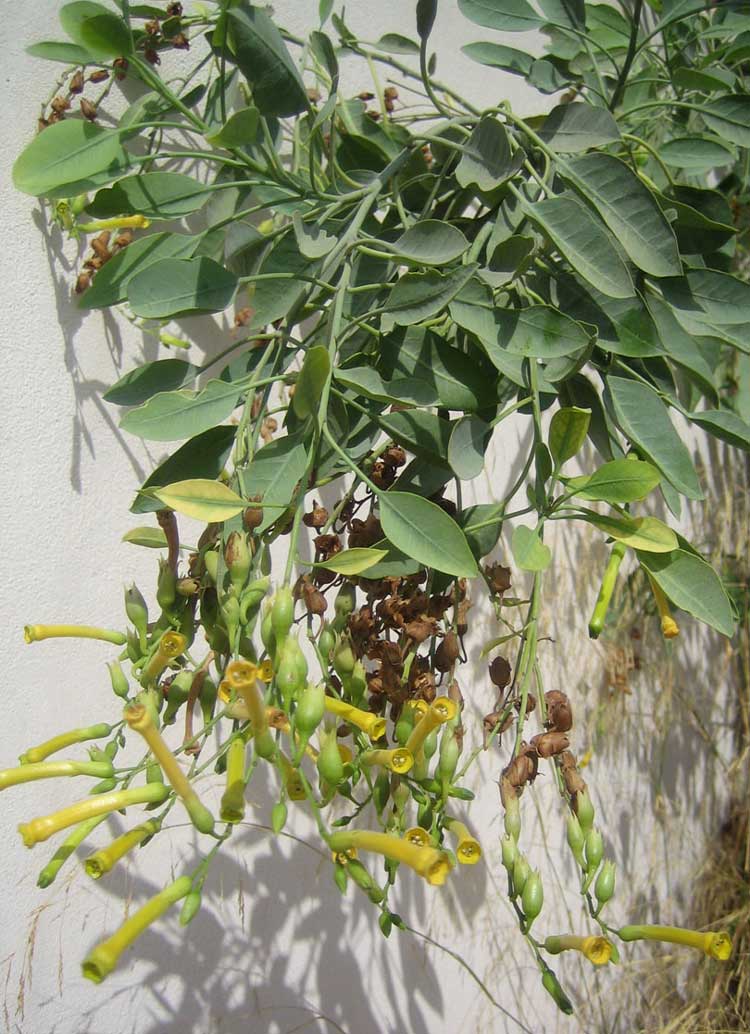
Nicotiana glauca
Classification System: APG IV
Superregnum: Eukaryota
Regnum: Plantae
Cladus: Angiosperms
Cladus: Eudicots
Cladus: Core eudicots
Cladus: Asterids
Cladus: Lamiids
Ordo: Solanales
Familia: Solanaceae
Subfamilia: Nicotianoideae
Tribus: Nicotianeae
Genus: Nicotiana
Sectio: Nicotiana sect. Noctiflorae
Species: Nicotiana glauca
Name
Nicotiana glauca Graham, 1828.
Synonyms
Homotypic
Nicotiana glauca f. genuina Millán, Revista Fac. Agron. Veterin. 6: 210. 1928, nom. inadmiss.
Nicotiana glauca var. typica Millán, Revista Fac. Agron. Veterin. 6: 209. 1928, nom. inadmiss.
Nicotidendron glauca (Graham) Griseb., Abh. Königl. Ges. Wiss. Göttingen 19: 216. 1874.
Siphaulax glabra Raf., Fl. Tellur. 3: 74. 1837 [1], nom. illeg. .
Heterotypic
Nicotiana glauca f. lateritia Lillo, Bol. Mus. Hist. Nat. Tucuman 1, no. 6: 14. 1925.
Nicotiana glauca var. angustifolia Comes, Atti Real Ist. Incoragg. Sci. Nat. Napoli (ser. 5) 1(1): 27. 1899.
Nicotiana glauca var. decurrens Comes, Atti Real Ist. Incoragg. Sci. Nat. Napoli (ser. 5) 1(1): 27. 1899.
Nicotiana glauca var. grandiflora Comes, Atti Real Ist. Incoragg. Sci. Nat. Napoli (ser. 5) 1(1): 27. 1899.
References
Graham, R. 1828. Edinburgh New Philosophical Journal. Edinburgh 5: 175. 1828; Bot. Mag. 55: t. 2837. 1828.
USDA, ARS, Germplasm Resources Information Network. Nicotiana glauca in the Germplasm Resources Information Network (GRIN), U.S. Department of Agriculture Agricultural Research Service. Accessed: 09-Oct-10.
Vernacular names
English: tree tobacco
español: Gandul o Tabaco morisco
suomi: Pensastupakka, sinitupakka
italiano: Tabacco glauco
sardu: Scova de forru
Nicotiana glauca is a species of flowering plant in the tobacco genus Nicotiana of the nightshade family Solanaceae. It is known by the common name tree tobacco. Its leaves are attached to the stalk by petioles (many other Nicotiana species have sessile leaves), and its leaves and stems are neither pubescent nor sticky like Nicotiana tabacum. It resembles Cestrum parqui but differs in the form of leaves and fusion of the outer floral parts. It grows to heights of more than two meters.
Tree tobacco is native to South America but it is now widespread as an introduced species on other continents. It is a common roadside weed in the southwestern United States, and an invasive plant species in California native plant habitats.
Description
Nicotiana glauca is a small tree or shrub with many branches that normally grows to over 2 m, but can reach as high as 7 m. Its leaves are thick and rubbery and can be up to 20 cm long. It has yellow tubular flowers about 5 cm long and 1 cm wide. The plant primarily reproduces by seed.[2]
Ecology
Nicotiana glauca can pose a threat to native species by outcompeting them for resources and is classified as an invasive species in many parts of the world. In some management programs, the beetle Malabris aculeata has been successfully deployed as a biological control agent. Every part of the plant is potentially poisonous to humans and livestock.[2]
Distribution
It is originally native to South America (including Colombia, Argentina, Chile, Paraguay, Uruguay, Brazil, Venezuela, Bolivia, Peru, and Ecuador),[1] but has been naturalized globally. It is found in Australia, warmer parts of Europe, temperate Asia, New Zealand, USA, Mexico, Hawaii, and Sub-Saharan Africa (including Kenya and Tanzania, where it is invasive, as well as Uganda).[2]
Vacant lot in Los Angeles with Nicotiana glauca plants.
It grows in a wide variety of open and disturbed habitats including lakeshores and roadsides, but is mainly a problem in relatively dry areas.[2]
Names
The plant is commonly known in English as tree tobacco, mustard tree, tobacco bush, tobacco plant, tobacco tree, and wild tobacco.[2] It is also known as blaugrüner tabak ("blue-green tobacco") in German.
In Spanish and throughout Latin America, it is known by many names including: tabaco moro ("Moorish tobacco"),[1] palancho, and palán palán.[3]
Its Latin name, Nicotiana glauca, was given to it in 1828 by Robert Graham (botanist).[1] The genus is named after Jean Nicot (c.1530-1600), a French ambassador to Portugal, who sent tobacco seeds and powdered leaves from Lisbon to France.[4]
Phylogeny
There are around 76 species in the Nicotiana genus,[1] the sole member of the Nicotianeae tribe. Phylogenetic research suggests the following species are closely related:[5]
|
|||||||||||||||||||
Uses
The plant is used for a variety of medicinal purposes and smoked by Native American groups.[6] The Cahuilla people used leaves interchangeably with other tobacco species in hunting rituals and as a poultice to treat swellings, bruises, cuts, wounds, boils, sores, inflamed throat, and swollen glands. It contains the toxic alkaloid anabasine and ingestion of the leaves can be fatal.[7] It is being investigated for use as a biofuel.[8]
References
"Nicotiana glauca Graham". Catalog of Life. Retrieved 16 February 2021.
"Nicotiana glauca (Tree Tobacco) Key". BioNET-EAFRINET.
"Description and images of Nicotiana galuca". Chileflora.
"nicotine (n.)". Online Etymology Dictionary. Retrieved 16 February 2021.
"Nicotiana glauca". Open Tree of Life. Retrieved 16 February 2021.
"BRIT - Native American Ethnobotany Database". naeb.brit.org. Retrieved 2020-04-07.
Foster, Steven (2002). Western Medicinal Plants and Herbs. Boston, NY: Houghton Mifflin Company. p. 339. ISBN 0-395-83806-1.
Media, BioAge. "Green Car Congress: Prickly Pears and Tree Tobacco for Ethanol Production in Semi-Arid Regions". www.greencarcongress.com. Retrieved 2017-03-12.
Retrieved from "http://en.wikipedia.org/"
All text is available under the terms of the GNU Free Documentation License

